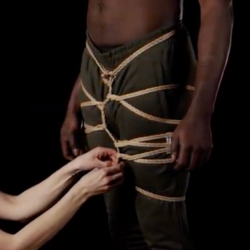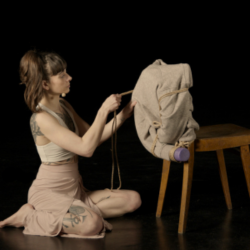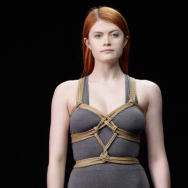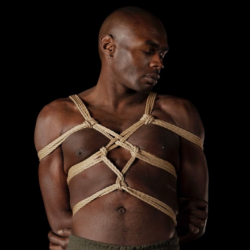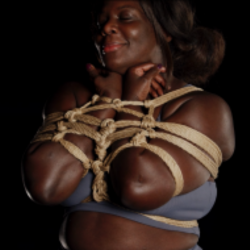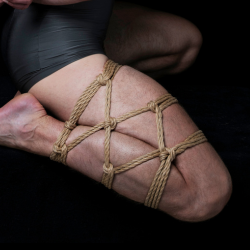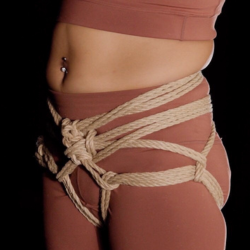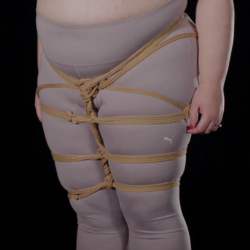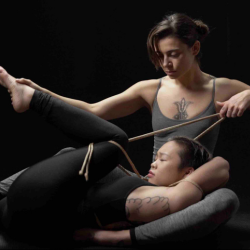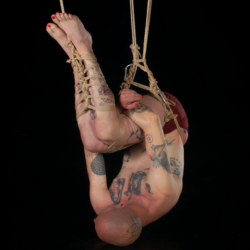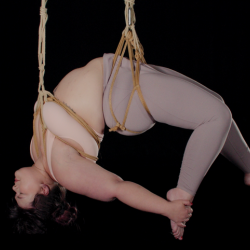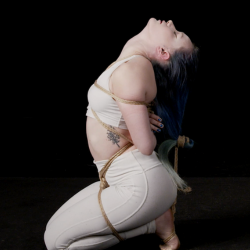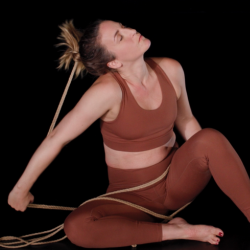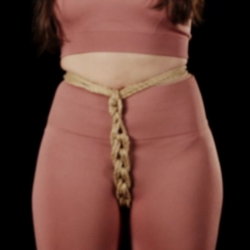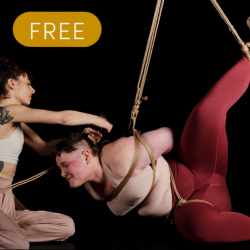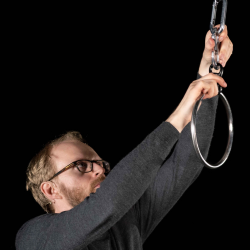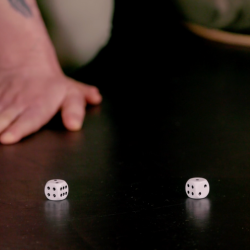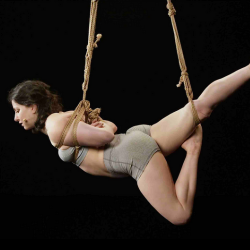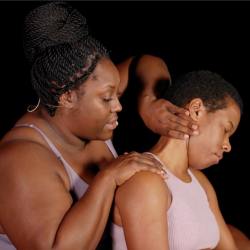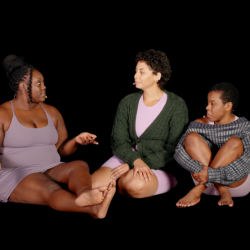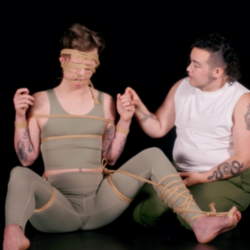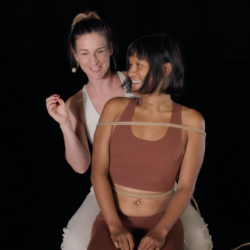EP 23
TIE ROPE TAKE PHOTO
Get ready for an electrifying podcast episode as Nick delves into various subjects, from the thrill of rope bombing and outdoor tying to the intersection of rope and photography and the creativity within constraints.

Nick (he/him) aka tie_rope_take_photo is a rigger and rope educator from Seattle. He has an eclectic rope style and is always developing new ties, body positions, and ways to get big reactions in rope. He’s been obsessed with rope since 2015 and is still delighted every time he learns something new.
Wicked Wren [00:00:18] Hello and welcome to the Shibari Study Podcast. I'm Wicked Wren and today I have on Nick. Nick goes by he/him pronouns, and you'll know Nick as @tie_rope_take_photo on Instagram. Nick is a rope top, rope instructor based in the Seattle area and also an award winner. Can you tell us a little bit about this very prestigious award that you won in 2019, I believe?
tie_rope_take_photo [00:00:45] 2019 Cutthroat Dungeon Co-Champion. So –
Wicked Wren [00:00:53] This is a very big deal.
tie_rope_take_photo [00:00:53] It is a big deal. I was specifically told by the people who put it on that I needed to put it on my FL profile. So yeah, so there was this competition that happens apparently yearly. It's called Cutthroat Dungeon. And over several rounds, you're given various ground ties to perform. But each time your opponents have bought challenges for you. So we had to tie a TK but, but my bottom had floaties on her arm or I had to tie a hog tie in with ribbons instead of rope or I had to tie a predicament, but I had to have a spoon in my mouth with a plastic egg in it. And any time the egg fell out, I had to stop what I was doing to go replace the egg.
Wicked Wren [00:01:49] I love it. You know, rope tops have had it too easy for too long. I feel like this is good for you.
tie_rope_take_photo [00:01:54] Oh, you know, yeah. Like everybody should suffer a little bit more and get to taste a little misery sometimes. And then the highlight of it was you had to explain why you'd done this ridiculous thing.
Wicked Wren [00:02:04] Oh, I love it. There's another thing about you that I think is very unique. We've done maybe 20, 25 episodes, and you're the second ex-professional poker player that's been on the podcast outside of the wonderful Tom.
tie_rope_take_photo [00:02:19] Yeah, I mean, tomporarily and I have an unfortunate amount in common. People... People when they know one of us and meet the other one, they're like, Oh, I get it now. There are two of you. That's bad.
Wicked Wren [00:02:30] It does seem like you're almost the same person in a lot of ways.
tie_rope_take_photo [00:02:35] There is a heavy amount of snark on both sides. Yeah, playfulness, humor. I have more hair, but yeah, other than that, it's pretty much the same.
Wicked Wren [00:02:44] Yeah, well, congratulations. Whenever someone is nervous about being on the Shibari Study Podcast, I want to say – but I don't say – I want to say "Don't worry, Tom did it. You'll be fine."
tie_rope_take_photo [00:02:56] I just listened to the MoBights episode, and I really appreciated that it was talking about community management. You're like, Oh, when you get someone like Tom out there and he tried to be like nice about it, and you're like, No, some people just want to watch the world burn. Such a highlight.
Wicked Wren [00:03:12] It's so funny because I did forget that I brought up Tom on that one and kind of, you know, maybe poked a little bit of fun at Tom. But, hey, it's hard. It's hard not to.
tie_rope_take_photo [00:03:22] Tom can take it. And listen, if tomporarily becomes a running theme through every episode of this podcast, I think everyone will be a little bit happier.
Wicked Wren [00:03:29] Yeah, we're doing fine if that happens. Well, you talk a lot about motivations in rope and why we do the things that we do. And when I look through your Instagram profile, it's really specific and it feels really authentic to you. So I think I would just like to start this with asking about your motivations. Why do you think you do well?
tie_rope_take_photo [00:03:49] So like, the thing that I love about rope is that it can go in so many different directions. That rope can be this thing that we're doing to connect with a person. It can be about (…). It can be about getting a really hot photo or a really hot video. It can be about pushing yourself and your partner athletically. It can be about grounding yourself and your body and getting meditative and all these somatic things with all these different reasons and motivations in rope and... And that's what I love about it. And I find my motivations varying wildly from time to time. There was a time when my – the only thing I wanted in the world was like come up with new cool ties and positions and like get the hottest, coolest, weirdest photo. And I found myself recently just over the last few months tying much (…) rope. It's been – like not necessarily directly about (…), although sometimes, but also just about like having that like... (…), dirty... I don't like... I lack the words but like almost perverse motivations and vibes and feelings in the ties. But I think I tie for a lot of different motivations depending on who I'm tying with and and what the feeling is at the time.
Wicked Wren [00:05:19] Why do you think you found (…) rope, dirtier rope, more quote-unquote (…) rope from being more just trying to do weird stuff and come up and make your own mark on rope if that makes sense.
tie_rope_take_photo [00:05:32] Yeah, well, so I look back at the photos I started taking when I was just starting rope. When I was just starting suspension and it's all, it's all (…) stuff. It's like I'm having freaking people in suspension and receiving BJs from people and they're in the air and like tying (…) onto people and splayed body parts and everything. And then, you know, I'm very nerdy, analytical, I get excited about the technical aspects of it. And I think also... I would see the amazing things other rope tops were doing. I would see these like cool ties that I couldn't fathom or amazing photos or positions, and I was like, Oh, that is the thing. That's the exciting thing. And I think, you know, we all do rope because we're trying to feel a certain sort of way about ourselves or get that serotonin boost or whatever that neurochemical boost for one reason or another. And one of those is like what you get in the moment while you tie. And one of those is, you know, you post a photo on the internet and people are excited about it. And I think for a while, you know, it was a little more of a focus on the second one of like, Oh, I want... I want to make these cool things and I want to be like, like the riggers that I've followed and appreciated and looked up to. And I think that after you've done that for a while, not that it, not that it's a bad motivation by any means, but you know, sometimes you've got to come back to your (…) roots and make it about butts a little bit more at the end of the day.
Wicked Wren [00:07:13] Yeah, that can only last so long. It's also exhausting to try to post things only to gain followers and to gain likes and things like that on social media. Very hard.
tie_rope_take_photo [00:07:24] Yes. You find yourself, you find yourself thinking about things that really shouldn't matter to you and really do. Like, What time of day do I need to post this thing? When, when is my engagement the most? Okay, well, at the end of the day, it probably shouldn't be a motivation.
Wicked Wren [00:07:38] Is that funny how most art does that where you start and all you want to do is make it and you are making some really (…) stuff and it was fun. And then you got technical with it. I feel like that's what everyone does whether it's photography or painting or whatever. And now you're going back to just kind of doing whatever you want to do. It's a neat arc. I feel like it's very common.
tie_rope_take_photo [00:08:00] Yeah, I mean, I don't – listen like I don't think I'm done with, with coming up with new ties or trying to take hot photos or even, you know, wanting attention on the internet. It just happens to be where the flow is with you right now. But, yeah, I think that, I think that everyone should get back to their roots, especially if the roots are particularly (…).
Wicked Wren [00:08:23] You talked about making new ties and new shapes.
tie_rope_take_photo [00:08:26] Yeah.
Wicked Wren [00:08:26] What did that look like?
tie_rope_take_photo [00:08:28] Again, like early on, I think I wanted to prove myself in rope. And I was like, If I can just come up with a tie that like becomes one of those canonical ties, like so-and-so is hip harness or this or that or whatever, if I can just do this, like, then I'll have made it." And I wish I would just come up with these ridiculous things. I came up with a fully spendable hip harness that like was also a (…) harness. Like, you could like fit a (…) in it quite nicely. It was not a niche that anybody wanted. Nobody was like, Oh, we need to suspend the (…).
Wicked Wren [00:09:13] Really serving a wide market.
tie_rope_take_photo [00:09:15] Yeah, exactly. So, so we do all these things and nobody ever gave a damn. But I mean, my friends would be like, Nick, you got to stop with this. But, you know, I was always innovating, coming up with stuff. And, and in the last couple of years, I actually have come up with things that people seem to like. I have –
Wicked Wren [00:09:35] Before we get there, let me ask you something. Did your friends actually say, Hey, Nick. Stop doing this. Was that, is that a real thing?
tie_rope_take_photo [00:09:45] No, I don't think they told me specifically, Stop trying to invent ties. I think that every time they just told me, This particular tie sucks and nobody cares about it. But I don't think they were trying to discourage innovation.
Wicked Wren [00:09:56] Yeah, I guess what I'm getting at is I feel most people want to do that in the beginning. When you start something. You immediately want to be like the person that has been doing it for ten-plus years, and you want to try to come up with something and people are like, Actually, that's already been fixed. And it was fixed 15 years ago with this thing. And I also think that that's hard within (…) because there's not a way to really research what has happened 15 years ago. There's no journals on this kind of stuff.
tie_rope_take_photo [00:10:28] Yeah, I think, I think to some degree, like if you come up with a thing, you distribute it and then if it's good, it will get wider, wider, whatever exposure. And then people – eventually you'll get to a point to be like, Oh, actually so-and-so made that seven years ago, and you're like, Oh, well... And of the things I've made, you know, apparently one of the ties that I'm most excited about that I came up with is similar to something that I don't even know if it's a canonical tie. There's like 30-year-old diagrams or maybe 50-year-old diagrams of somebody doing a similar thing that's tied completely differently.
Wicked Wren [00:11:07] What is it?
tie_rope_take_photo [00:11:08] So I have a tie called the Bimbo Tie, or sometimes the Thembo Tie or the Himbo Tie or the Presentation Tie, depending on your relationship to the bimbo. It is a non-suspendable for three to four rope ground tie because that's what everyone's been looking for. It's like a finicky four-rope tie that they can't get in the air. But it sort of ties – it brings the shoulders back, the elbows in, ties the wrists to the hips and then like forces a bend in the lower back. So it sort of forces your shoulders back, your chest out, and an arch in your back and makes you stick your butt out.
Wicked Wren [00:11:48] I love that.
tie_rope_take_photo [00:11:49] Which... Yeah. As it turns out, was really all I've been looking for in this world.
Wicked Wren [00:11:54] You're like, I found it.
tie_rope_take_photo [00:11:56] I found it. I'm the thing.
Wicked Wren [00:11:56] Have you found the, the diagrams for that stuff? And that's got to be kind of cool.
tie_rope_take_photo [00:12:01] Yeah. Somebody showed me this thing and they were like, Oh, there's this – it looks like it's from the fifties or something. It's tied completely differently. And frankly, I think if you actually put it on someone. It might kill them. It seems like much more of a theoretical thing than something actually people did. But it does definitely have a similar effect.
Wicked Wren [00:12:22] I don't think there's anything wrong with that because I do that with photos and things where I'll come up with an idea and then I realize, Oh, that's been done 80 times. But as long as that doesn't come from a place of ego saying, I want this to be my legacy, and you're actually making stuff that you like and is contributing to the world, I think it's great.
tie_rope_take_photo [00:12:40] Yeah. I mean, another thing that I've come up with recently and... As I distribute this, we'll find out whether there's a similar thing out there, is we were teaching people in one of the classes, the organization I teach. We're teaching people this (…) or harness to tie a (…) or onto someone. And it was so finicky. I got so annoyed with it that I went home with a partner and made them stand there for 90 minutes, getting intermittently vibrated while I figure it out. A good version or a better version of a (…) or harness. So now I feel like maybe I have come up with the canonical (…) or tie, but who knows, maybe it already exists somewhere.
Wicked Wren [00:13:22] I love it. So it was like you were doing some labbing and then your partner had edging sessions.
tie_rope_take_photo [00:13:27] Yes, exactly that. Yeah. Yeah.
Wicked Wren [00:13:29] It's great. Out of curiosity, do you connect rope or do you tie off everything usually?
tie_rope_take_photo [00:13:36] Yeah, I usually... I usually connect rope unless I'm, you know, there's certain schools of rope sort of more Naka-esque where you just tie on a new rope every time. If I'm trying to do something in that vein, I'll usually tie on a new rope but most of the time I connect rope.
Wicked Wren [00:13:56] Has that always been the same or has that changed?
tie_rope_take_photo [00:13:59] It's always been the same. I... Not to get too into schools and dogma, but if – when I started seven or eight years ago in Seattle, there wasn't as much of like a focus on Naka-style rope and so I would always just like connect rope. And now it's become much more fashionable to do well, the Naka stuff.
Wicked Wren [00:14:21] I am curious. What was it like when you started? What was the current trend of Seattle rope?
tie_rope_take_photo [00:14:27] Seattle was very interesting because it didn't have the exposure to outside instructors that a lot of other places have. So it was very much this tradition of Western rope bondage. People did not do TKs. Apparently TKs came to Seattle about 15 years ago and two people immediately got radial nerve damage. Like you do when you tie TKs and you don't know what you're doing and you suspend it. And so like the conference of the six actual competent Seattle rope tops happened and they got together and, We can't tie these things, they're awful. And that became.. That was just like the rule in Seattle is you don't – you didn't suspend TKs and nobody even really tied TKs. And so when I was coming into the scene, it was sort of this forbidden fruit, almost, where like TKs were treated like... This ultimate tie that you could do all this like cool suspension stuff in, but you weren't good enough to do it. And like, you know, that was for somebody else. So that was for people who are more advanced. And they weren't tied on the ground for scenes. Like nobody was just like scening with the TK. It wasn't clear to me early on like, Oh, this could be a hot thing. You just tie this on your partner, go be with them, and your body's against their body and there's a bondage involved and they like it, and then it comes off. It was just this like very suspension-oriented mindset. So that's something that I hope shifts both like in Seattle and other places as well, that that, you know, sometimes these ties, the point isn't about what you can do with it suspension-wise, but just what it's like going on and off.
Wicked Wren [00:16:12] Yeah. I think that no matter what you tie, that's something that has to be learned, where it's not about the tie you're doing specifically, it's about how you're making each other feel. But I do have a question. How did you learn how to do a TK? When was the first time you did it?
tie_rope_take_photo [00:16:27] Somebody in an early rope jam I went to in Seattle taught it to me and I'm sure I tied a horrible, horrible, horrible TK. And then there was someone who was starting to teach rope classes in Seattle who'd done a lot of studying in Japan. And so I learned TKs from that person and then traveled more and more.
Wicked Wren [00:16:53] You have a cool little FAQ on your Instagram. I really like it because you say, In-person instruction is the best, but if you can't find it, Shibari Study is the second best, which – shoutout to Shibari Study – but also for very free, there's YouTube stuff and in the rope world, we always kind of talk crap about YouTube and how bad it is, but you can learn stuff from there as long as you do it within context. If you're not trying to suspend someone and do all this kind of crazy things.
tie_rope_take_photo [00:17:21] 100% facts. I think people are very freaked out by safety stuff and they should be in some contexts. But like, if it's not going into the air, there's a minimum to how much damage you're going to do to someone. As long as you're not like tying rope that cinches around their neck or face or some other like incredibly risky part of the body. You know, any tie you get off of YouTube, if it's not going in the air, you're going to be fine.
Wicked Wren [00:17:43] Yeah. Agreed.
tie_rope_take_photo [00:17:44] I think also people don't realize like, just like how much their communities can be a resource too. Like just show up at events. I know it's terrifying. I know that like, it's hard to go to a place where you feel like everybody else knows each other and you don't know anybody. You don't know how to behave or whatnot. But like, it really is a pretty welcoming community for the most part, in my experience.
Wicked Wren [00:18:04] Same, in my experience, too. Speaking of rope safety, I know you have thoughts on this.
tie_rope_take_photo [00:18:09] I have so many thoughts about rope safety. I have definitely read every single post in the FL Rope Incident Reports group. I – every once in a while on Instagram, I'll just sort of like ask questions to learn more about people's experiences with various safety and incidents. I have... One of my hot takes about rope safety is that I feel like people are more freaked out about fainting than they need to be. And if someone who is more of a medical expert than me wants to come along, tell me I'm wrong. That's fine. But I've talked to people. I've talked to friends who are medical doctors who are also in the rope world. And other than like, you know, falling down and conking your head and dying, which obviously isn't great, if you are suspended and you're not going to drop and you faint. It's basically a nap as long as you're still breathing and as long as your body is still functioning. Like there's nothing horrific going on there. Naps are great. Everyone loves naps and like, as a rope top, I don't think – I think there's this focus often with rope safety is like cutting people out of rope. And if there's one thing I can talk people away from, it's trying to cut people out of suspension during emergencies. I think we need like more of a focus on physically supporting the person with your body, with furniture, call somebody else over, have them support them, lower them to the ground, try and be in a controlled way. What you don't want to create is an uncontrolled drop. Like the extra 20 seconds are saving them from cutting suspension lines is not worth dropping them out of suspension. And then, like, I think your main responsibility as a top when someone faints in your rope is creating a good environment for them to regain consciousness in. If you're freaking out, they're going to be freaking out. They're gonna be disoriented, they're going to come to you and be like, Oh, no, something horrible happened. And if you create this welcoming environment, you're like, Hey, you went out, but it's fine. Then like, it's fine. I think that's – sorry, I'm just starting to rant here. But I think that's this thing in (…) in general is that... How we perceive events often is very colored by how those events were handled over like, what was the emotional tenor or in subsequent events. And I don't want to say that like, it's okay to go around hurting people physically or emotionally. But just as important as whether you do hurt someone physically or emotionally is how you handle it and how you repair the relationship afterwards. And I think that's the thing that people often don't get. Because it's very easy to get in this like defensive mind space of like, Oh, no, I have to protect myself and protect my reputation, or something along, I don't even want to think of myself as like someone who created this. But if you handle it gracefully like it doesn't have to be a big deal.
Wicked Wren [00:21:00] Yeah, it's not, if you get hurt, it's when you get hurt. And the majority of the time, physical injuries are not that bad. But the emotional side is a completely different topic that is really, really difficult to deal with because we don't have structures in place for that in the (…) scene. In the rope scene.
tie_rope_take_photo [00:21:22] Right. Yeah. And it's you know, it's very easy to give people the checklist of like, do this, do this, do this, do this. You won't injure someone in rope suspension. But you don't have that like... Like you say, you don't have that guide map of like, here's how to navigate these relationship, these relationship issues that come up so often. And, you know, sometimes people just like aren't good fits for each other. And that needs to be okay, too. And I think also we have in (…), it feels like we don't have ways to say that something was bad without framing it as consent incidents. And I don't like that because someone's just like, sometimes someone's a crappy partner or like a crappy person and you don't need to frame it in terms of consent. You just be like, This person sucked as a romantic partner and I wouldn't suggest anybody date them, but like, they're not going to go around like groping people. And we need sort of like a little bit more nuance in all of these things to be able to be like, Okay, well. They're not a monster, but also they're not great.
Wicked Wren [00:22:27] Yeah. It's so difficult to do. Because really the only way we connect is through Instagram. FL. Things like that and it's just not possible to... If we have Google sheets that go around and things like that, but it's just very, very difficult for any kind of real accountability and learning like that.
tie_rope_take_photo [00:22:47] Yeah, I heard a phrase I really like, which is that, Call-outs only happen in one volume. That like once, once you say the thing like it's so hard to like, say like, Okay, they did bad, but they only did this bad because people, yow know, it gets blown up. And that's not to say that... I want to acknowledge that bottoms have had a really horrible time in rope historically. Like there's just been – if you go back five or ten years and look at all of the big rope tops who are headlining the concert, none of these people are around and all of it is because of crappy behavior for the most part. So I don't want to minimize what rope bottoms had to deal with by any means.
Wicked Wren [00:23:26] Yeah. Even with how a call-out works, it doesn't really work because all it does is make that person leave and then they go and they offend again and they get new partners and those people don't know anything that's going on. It's just a bad cycle. Call-ins work better than call-outs, but the issue of the call-in is you have to have somebody that can mediate that and make it happen. And there's nobody that can really do that because it's a hobby for people. It's a scene for people.
tie_rope_take_photo [00:23:54] Yeah. And I know people who've been a part of accountability circles and try to do that, like mediation in between work and gotten just completely burned in the process. I think the thing that affects these things is in terms of like accountability and processes and call-outs and all of that, call-ins, is relationships and community. That like... If I'm really close to someone and I create harm with them, like obviously I'm going to be invested in making sure that they come out of it feeling better. And, you know, if I have a group of people who I'm really close to, then I'm going to be invested in, you know, I don't know, doing the things that those people are encouraging me to do to continue to be a part of that community. So the more the people are part of the community and the more that they have those connections, I think like, the better chance there is of having this thing. So the point is to like not just like exclude people when they mess up. But to be inclusive and to be a supportive environment and be like, Hey, I really like you. And like this thing needs to change.
Wicked Wren [00:25:04] Yeah, there are obviously things that are exceptions to that rule like really extreme cases. But I imagine the majority of those cases aren't super extreme. But yeah, it definitely does start in your local environments. At the functions, bring them in that kind of stuff.
tie_rope_take_photo [00:25:21] Right. And listen, like I know some people who've had patterns of behavior where I'm like, I cannot even interact with this person anymore. Like, it's just – we're talking about dozens and dozens of things. But when someone, you know, people are inevitably going to mess up.
Wicked Wren [00:25:35] Yes.
tie_rope_take_photo [00:25:36] That and... And it's how, it's how they proceed from that and whether they continue to make the same mistakes over and over or whether they change that like ultimately determines how worthwhile a person they are to be with.
Wicked Wren [00:25:49] Yeah. Yeah. And how they react to that and stuff. I would love to talk to a little bit about rope bombing because you have a ton of that on your page.
tie_rope_take_photo [00:25:59] Yeah. Yeah. That was another thing where, you know, I would start in rope and I would see people do these crazy photos in crazy places and I was like, That. I love that. And especially during the early pandemic, you know, I lost my job one month into the pandemic. My primary partner is a teacher and... So she has summers off and we just hiked every day. We would just, you know, I would like look up places we could go, old abandoned structures or whatnot and. Yeah. And we would like tie off of these things and, and each thing – it was cool because each, each setting that you're in is a new thing and it inspires different shapes. Different ways of interacting with it.
Wicked Wren [00:26:51] What is it? Is it the thrill of being outside and having to work quickly and efficiently? Like what is the thrill around it?
tie_rope_take_photo [00:27:00] I think the thrill is – it's a great question – I think the thrill is adapting to a new situation. And just, like if it gets so formulaic, I think for me, you know, you tie in your whatever, your rope room or your local dungeon and it's the same thing over and over again. And maybe you're doing slightly different things, but new constraints or new inputs end up with new outputs. And so, you know, if I'd be in a place like I maybe I'm underneath a railroad trestle and you've got like these wood beams crisscrossing and we try and tie something that was geometric and would mirror those lines, or you'd have something like a setting that's like, Oh, you're in this garden and it's very serene. And we try to do something that like looked more relaxed and elegant and droopy. Yeah, just trying to like respond to a thing. I think constraints lead to creativity.
Wicked Wren [00:27:59] I agree fully. There has to be constraints of things. I hate having just a blank page.
tie_rope_take_photo [00:28:04] Blank pages are the worst. Yes.
Wicked Wren [00:28:06] So stressful.
tie_rope_take_photo [00:28:07] And just as a top, like speaking to bottoms or anybody I might ever tie prospectively. Like, I always need that input. You know, you go and you're like, Tell me about yourself. Tell me what you like, blah, blah, blah, blah, blah. And when people tell you things, like that starts to shape these ideas, this creativity. I get excited when someone I'm going to tie with for the first time has like, Oh, I have shoulder issues here and I can't do this, I can't do that, and blah, blah, blah. Like awesome. Like, I get to like take on this challenge of finding a way to deal with this set of circumstances. And when someone's like, I don't know, surprise me. Like anything's good, then you're like, I don't know, like...
Wicked Wren [00:28:46] Yeah, you're like, I don't know what like... I tell this story a lot. I love to cook and when people are coming over for dinner, when they say, I eat anything, it's awful. But they say I don't like X, Y, Z and I love fish. You're like, Freak yeah. Now I have constraints to work into. Or a lot of people think that vegetarians and vegans are annoying to cook for. I think it's fun as a, as a mediator, I think it's fun because now I'm going to think about stuff differently.
tie_rope_take_photo [00:29:13] Speaking of confluence of rope and cooking and vegetarianism, veganism, I go to Burning Man every year, most years and do rope stuff there. And I have – metamor is planning this event for this upcoming Burn. And this is – for those who haven't been to the Burning Man – this is sort of part for the course in terms of like a silly insanity. His idea was he wants to cook a bunch of fried chicken and then have us tie people up in sort of like chicken wing ties and then have people like (…) fed fried chicken while they're tied to a thing and just sort of like assembly line hundreds of people through this if we can. So that's part of what I'm trying to organize right now. And one of the issues I'm running into is that like a lot of the people who might be willing to volunteer as feeders or tyers are vegetarian or vegan, and they're like, That sounds like a great idea but also, it should revulse me.
Wicked Wren [00:30:11] But also – that is pretty funny. Nothing sounds worse to me than being in the desert in like a 110 heat being fed chicken in a rope. But I'm sure there are some people out there that are really, really going to love it. It's gonna be really successful.
tie_rope_take_photo [00:30:31] You think you wouldn't want heavy food out there. But like, I find myself like craving that like greasy heavy food out there.
Wicked Wren [00:30:40] I've never been.
tie_rope_take_photo [00:30:40] I mean... Don't go, like... I don't want to be – so it's funny, you know, a lot of the things that I really like are things that I made fun of for years. So, like, like 15 years ago, I remember people like trying to get me to go to Burning Man. I was like, Why would I? You know, why do I want to go to this thing? It's freaking 100,000 people in the desert all expressing their individuality with the same hat? Like that's so stupid. It's like, why would I ever do that? Or even, even rope bondage. Like, I got into rope bondage. I had this partner. She did more. I was just getting into the (…) scene. She had more experience in the (…) scene. She'd done a lot of rope that she'd liked and at the time I was really into like impact and rough body play. And she was like, Hey, what do you think about rope? And I was like, I don't know. It just seems sort of like dry and dull and boring and stale and slow. Like you're just going to stand there while I tie you up. What's the point of that? And she said, Well, people love rope, so figure it out. And I was like...
Wicked Wren [00:31:37] (Inaudible).
tie_rope_take_photo [00:31:38] Fine. But I'm not going to become one of those like tiresome, shibari idiots who suspend people from the ceiling. Sort of like – I'm just going to use like quick utilitarian dirty ties. And now skip to years later, and I'm the most tiresome Shibari idiot possible.
Wicked Wren [00:31:51] Yeah. You got a whole room for it probably. You got tatami mats.
tie_rope_take_photo [00:31:55] I do not have a tatami mat. But I do have a room for it.
Wicked Wren [00:31:57] Like we're gonna get you a tatami mat.
tie_rope_take_photo [00:31:59] Oh, excellent. Hey, you know what? I'll take it.
Wicked Wren [00:32:02] I do have a question about your relationship to the camera because your username is tie_rope_take_photo. I think it's very funny. You do a lot of rope bombing which is primarily camera-focused because it's about capturing that moment. How does a camera play into rope bondage for you?
tie_rope_take_photo [00:32:22] Okay, Well, first thing I want to call out is that I need to acknowledge that I'm a horrible photographer.
Wicked Wren [00:32:27] It's not true.
tie_rope_take_photo [00:32:28] Thank you. That's very kind. I think... I think that I have... very – I got ideas about framing the positions I want, like modeling how I want the thing to look and I can make that happen. And then like in terms of actually using the camera well, I'm just like the worst but I'm learning.
Wicked Wren [00:32:50] Yeah, but that – I feel like I do want to say something about that and it's not... Shoot on auto. You know, it doesn't matter.
tie_rope_take_photo [00:32:57] I do. 100% I do. I shoot on auto.
Wicked Wren [00:33:00] Use natural light. It just doesn't freaking matter because the subjects are cool. You talked a little bit earlier about having a bridge with lines and you're going to make lines and things like that. You can take that photo on a potato. This isn't to you, this is just like my general thoughts is that you could take it on a flip phone and that photo is going to be good because it's all about what you're taking a photo of.
tie_rope_take_photo [00:33:21] I mean, it was up until like a year... A year and change ago, I was just like everything was on my iPhone and I got a camera. And frankly like I don't know if you can tell the difference picture quality-wise. The camera is interesting. We talked about motivations, like it changes the motivations. It changes the way you interact with your partner. Like when I'm doing photo rope, it's much more, you know, in a scene, I want to be in charge. I want to be driving the bus. I want them to like just be reacting to what I'm doing. And it's all about like me imposing myself on them or can be. When doing photo rope, my expectations are once around communication and sort of the paradigm of the scene is different. It becomes much more collaborative. I've been lucky to work with incredible bottoms. My primary partner Alice, @one.time.at.band.camp2 on Instagram, is an incredible bottom, and so relying on those people to, you know, communicate what they need in terms of comfort, sustainability, to help me come up with ideas in those spaces, it's just like an entirely different process than it is if you're tying for, for different motivation.
Wicked Wren [00:34:42] Absolutely. Can you talk a little bit about the precautions, about the preparations and things like that you take when you photobomb things or ropebomb on things?
tie_rope_take_photo [00:34:54] The one thing that I'll say and... The world is not happy about a masc person tying up a femme person. You know... A lot of times and I live in a very progressive area like I live in Seattle. People here are pretty open-minded and there's still a lot of good nature checking in where people are like, Hey, is that consensual or is this a crime? Like what? How bad a thing is this? So 1), just like having your bottom – if it's a femme bottom and a masc top having like the bottom be like, I'm great, like everything's fine. Make them really like, don't push the suffering in a place where, where it might be interpreted as a nonconsensual act. And I would say like if you could have a third person along who is a spotter and they are femme or just like one other femme person along somewhere, so it just doesn't look like four guys in the woods murdering a small woman is like... That is the number one thing that I've learned. But yeah, think about lighting. Think about onlookers and onlooker management. Think about the safety of the thing that you're tying off of. Like evaluating – this is a thing that I've learned about sort of like evaluating materials and sort of hard points in nature. I have a friend who insists on me pointing out that they are not in architecture because apparently, like you get kicked out of architecture if you say you're an architect, but you're not. But they have some of the training that architects have. And so like I will send this person photos would be like, how safe or not safe is this thing? It turns out I was very close to destroying a historical bridge by trying to suspend somebody off of it. I'm glad that I checked in with them first.
Wicked Wren [00:36:40] Yeah, me too.
tie_rope_take_photo [00:36:41] Yeah.
Wicked Wren [00:36:42] The unsung hero of rope bombing.
tie_rope_take_photo [00:36:44] Right. And when I say I was close to destroying the historical bridge, I was also close to dropping part of a historical bridge on a rope partner. So maybe I should focus on that part.
Wicked Wren [00:36:54] Yeah. You've been learning rope for about eight years and you're just starting to teach. What are some of the things that you're excited to teach?
tie_rope_take_photo [00:37:03] Oh, I'm excited to teach things – well, so, my first like pure real class that I'm teaching on my own is about dealing with emergencies in rope suspension. Just because that was something that I felt like my community could use. But I want to teach things... My favorite classes were about harness space. They were like, Here is a principle that you can apply in various situations. So like, rather than be like, Here is my TK, it was like, Here is this – actually, I'm just going to shoutout my favorite rope instructor of all time, is this person named Blizzard. She has apparently like completely disappeared from rope but she was in sort of like the Baltimore DMV area and I took maybe like half a dozen classes with her at cons and every time was just mind-blowingly good. And I could yammer about her forever. So I'll try and cut it short. But she would teach things that would be like, Here's like a cool chokey addition you can do on an upper body tie and here are the things that make it work. And now you can tie this as arms free harness. You can tie this as a TK. Here are the building blocks that you can add to the things that you already know and use. And that's the kind of stuff I would teach. So one of the classes that I have in sort of in the barrel in preparation is incorporating Naka panties. If people are familiar with the tie Naka panties in the vertical suspensions and how to like just make everything easier. Because I know a lot of people have a lot of issues with vertical suspension stuff. That's the number one thing that makes people faint, is sort of like a vertically loaded waist rope. And so people have this like hot, sweaty, fainty, nauseous vagal reactions. And so, you know, for people who've tied – to give a little harness here – for people who tied the Butterfly Harness with the Naka panty addition. It sort of loads more into the thighs and under the butt. And the butt's a great place to take load with rope. But it doesn't have to just be the Butterfly Harness, you can tie other structures and still sort of flow into that. So it's more of a proof of concept of like, you can do this and make everything easier for vertical suspensions. At con, we were playing around with this and we suspended somebody from just like, from just under their butt and their hair and just like did that. And it was shockingly comfortable.
Wicked Wren [00:39:35] It also sounds cool because you can take away the Naka panties and then have that waist rope and then maybe before that person gets to a point where they're going to faint or something, you can like put some tension on the Naka panties to just give some relief there. Like, it just sounds like it's just more options.
tie_rope_take_photo [00:39:51] Yeah, yeah, a lot of options and yeah, that's all I want people to have is more options and more troubleshooting for the things that they've found to be obstacles. I think a lot of people think like, Oh, I can't do TKs or I can't do vertical suspensions or I can't do this or I can't do that. And maybe it's like you can't do it in the one way that you've been trying it. And there's like other things, other things to come to. I'll say this also about teaching. This wasn't the question but I know that when I was first taking rope classes, I would go into classes, especially like early suspension classes and the top would tie this thing on their bottom and I would tie it as close as I could. And my bottom couldn't handle the thing. And I tried not to be crappy but like somebody would be like, Oh, like what's wrong with my partner? But the thing was that... The person teaching the tie wasn't calling out, I chose this tie to teach because it's a thing that works really well for my bottom or my partner, and acknowledging that that like people have different strengths or challenges in rope and rope suspension and that like... Just because you see people doing this insane thing, it doesn't mean that they're like super tough and everything. It means they're super strong in this thing and finding out what works for your body and what doesn't work for your body and wanting to adapt to it is – that's half the game.
Wicked Wren [00:41:25] It's like you're trying to follow along with some pattern that you've seen once and then trying to just simply remember the pattern. And it's difficult to even give qualified feedback as a bottom because I can't really tell you if the tension is on or off because we're both trying to just keep up with –
tie_rope_take_photo [00:41:48] I've never been in this. I don't know what's supposed to feel like. Yeah, like yeah. Maybe this is supposed to be like dissecting my midsection and half, who could say.
Wicked Wren [00:41:57] I was going to say on your other thought there with having someone teach a harness without saying kind of why they're doing it. I heard someone – I can't remember who it was – critique when teachers say things like, This is how it works for me, but it's going to be different on your body. And as a teacher, it's your job to know how it's supposed to work on someone else's body. That's why you're teaching, right?
tie_rope_take_photo [00:42:21] Yeah, yeah, yeah. I, you know, I've been doing rope, as you said, for eight years. I'm just starting to teach now. And part of it was, I'm not happy teaching a class being like, Here is a tie that works well on my partner, when I show a tie or an idea or some things, I want to be able to adapt it to other people as well. So I want to know not just like the primary thing but all the questions that come out of it.
Wicked Wren [00:42:46] Yeah, yeah. That's the concept of teaching. Understanding how it's going to work on multiple bodies and being able to see all those pitfalls because if not, you're just really demonstrating what – it's kind of a show and tell between you and your partner.
tie_rope_take_photo [00:43:02] Absolutely. Yeah. And, and I've heard people say like, you don't teach to 100%. You don't teach to the limit of what you know, what you can do. You teach to like 25%, 50% whatever. You have that in reserve so that like when people have questions or whatever like you know more you have that, you have that in reserve.
Wicked Wren [00:43:19] Yeah. Even with that thought, whenever I see people I've been tying for ten years. The things that they will ask are so minute like... I was in a class at the Bank and my friend Lief asked about how someone was tying their single-column and how they were doing this one little specific thing with the bight and this and that. And it was like so small but it was awesome.
tie_rope_take_photo [00:43:49] The funny thing is, is that like when you start, you don't know anything. And so it's drinking from a fire hose. Like, you'll take a class, you'll be like, Oh my God, that's so much, and your brain is so full. I would go to like cons in my first year or two and just be like, Holy crap. Like there's no way, I'm going to retain all of this. And of course, I didn't. But if you get even like, if you remember even a quarter of it, you're doing great. And then, you know, the more you learn and the more you've done it, if you learn one new thing that you get to use, that's exciting. Like, you know, if I go to a 90-minute class and there's that one thing that they showed that I would incorporate into my tying, this was worth it.
Wicked Wren [00:44:25] Yeah. Well, that only happens with a lot of time, a lot of repetitions and things.
tie_rope_take_photo [00:44:30] Yeah, absolutely. Yeah.
Wicked Wren [00:44:33] What are your upcoming classes? Do you have anything like scheduled to teach?
tie_rope_take_photo [00:44:37] I do. Locally in Seattle. I've got a, I've got an emergency management class coming up in two weeks. Emergency management in rope suspension. I especially call it emergency management and not emergency descent because I feel like people are always trying to like... Get someone out of suspension as fast as possible and sometimes there's better ways to manage emergencies, so...
Wicked Wren [00:44:59] Give me the bullet points. Give me like the quick three bullet points of the class.
tie_rope_take_photo [00:45:04] One) Don't panic. Two) Most times that a bottom is going through a rough time, they and you will be better off if you just physically support their body for a little while, while you think about how you're going to address the issue rather than like trying to bring it down immediately. Like you can lift them with your arms, you can get underneath them to squat them, you can put a chair underneath them, you can have, call someone else over and help carry them. Just like take a little bit of the load off. Give them a chance to breathe and give yourself a chance to think rather than just like, Oh, I got to go get them down. That's number two. Number three, I know we talked about this. But fainting is not – we talked about this thing. Fainting is not as bad as people think. It's going to happen and handle it gracefully. Actually, just handle, handle things gracefully when they happen, I guess is number three.
Wicked Wren [00:46:00] Things are not as intense as they seem.
tie_rope_take_photo [00:46:03] Yeah, I think it's really easy to catastrophize. Like, Oh, no, I did this to my partner. Oh, I'm a bad bottom. Oh, I'm a bad person. Oh, you're irresponsible. But, you know, it's how you handle it.
Wicked Wren [00:46:14] It is. I would, you just said, I'm a bad bottom. I'm this/that. I would like to hear a class about how we talk to each other in rope because I feel like a lot of the times if someone has to call it and it's always a bottom saying like, I can't do this anymore, I need a break, I need to come down, that quantifies it as a failure. And that's really harmful in words. And yeah, it would be a really cool class to like talk about reworking conversation structure.
tie_rope_take_photo [00:46:42] Yeah, yeah, absolutely. And when you need to call it like that's not bad. That's, You did a good job.
Wicked Wren [00:46:50] That's the thing. Yes.
tie_rope_take_photo [00:46:52] It's, it's, if you let yourself get injured, that's the bad thing. If you like try and tough it out and, and break something like that's the bad thing. Taking care of yourself and advocating for yourself is the thing that we need. Because if you're, you know, as a top from tying with a bottom and they don't speak up for themselves that's when I'm terrified.
Wicked Wren [00:47:12] Yeah I tie with KissMeDeadlyDoll a bunch and then we tied and I was spent and it was a very short tie. I was done and I was, I got done and I apologized to her so much I was like, I am so sorry. And she's like, Stop saying you're sorry. I'm happy because this is what I wanted to do to you. I wanted you to get to the edge and not be able to handle anymore. And I was like, Oh, now I feel good.
tie_rope_take_photo [00:47:35] Yeah, yeah. And I think, I think it's very easy to feel like, Oh, I ruined the fun. Or, Oh, I failed. Or, Oh, I wasn't tough enough. But like, that's not the point of it.
Wicked Wren [00:47:44] Yeah. Well, in wrapping this up, I want to thank you for being on. This is an awesome conversation. I learned a lot. Very, very cool stuff. Where can people find you? You said you have some classes coming up. Is there anything else coming up you want to tell us about?
tie_rope_take_photo [00:48:00] So yeah. So I think that class emergency management class, I am teaching a rough body play class. I'll hopefully have links on my @tie.rope.teach.classes Instagram account. I try to keep my accounts separate because like, I realize that most people are going to my main accounts to like, look at hot pictures of rope and butts and like not necessarily be advertised to. So yeah, rough body play class then and then we'll have this class about Naka panties making everything easier in vertical suspension. That's going to be coming soon. I don't think we have a date set just yet.
Wicked Wren [00:48:40] Well, I want to thank you for being on. This is awesome.
tie_rope_take_photo [00:48:43] Thank you so much for having me. I'm a big fan of the podcast, so it's a pleasure to be a part.
Start your free 7-day trial
Get one free week of unlimited access at Shibari Study,
then pay from $17.90/month. Cancel anytime.


